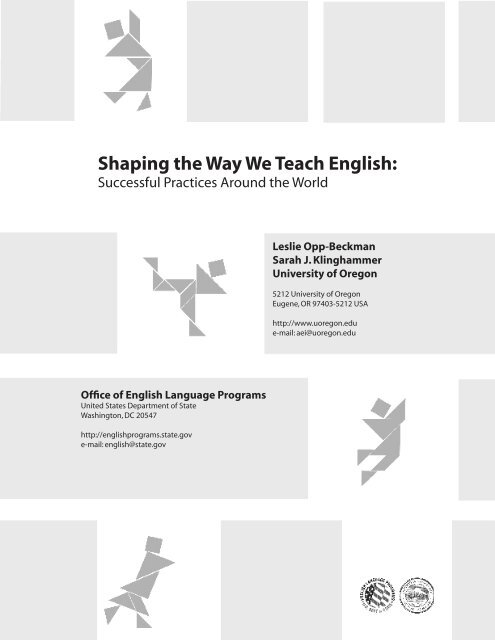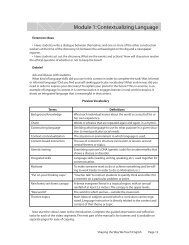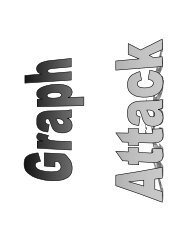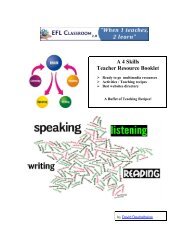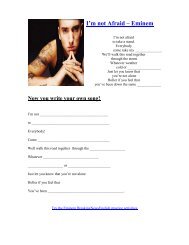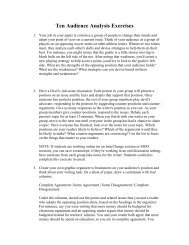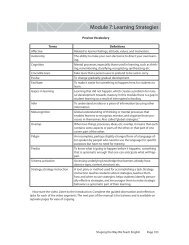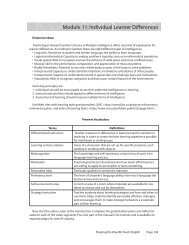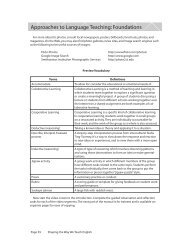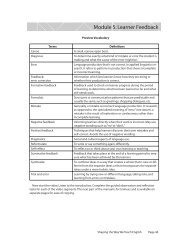Shaping the Way We Teach English: - EFL Classroom 2.0
Shaping the Way We Teach English: - EFL Classroom 2.0
Shaping the Way We Teach English: - EFL Classroom 2.0
You also want an ePaper? Increase the reach of your titles
YUMPU automatically turns print PDFs into web optimized ePapers that Google loves.
<strong>Shaping</strong> <strong>the</strong> <strong>Way</strong> <strong>We</strong> <strong>Teach</strong> <strong>English</strong>:<br />
Successful Practices Around <strong>the</strong> World<br />
Leslie Opp-Beckman<br />
Sarah J. Klinghammer<br />
University of Oregon<br />
5212 University of Oregon<br />
Eugene, OR 97403-5212 USA<br />
http://www.uoregon.edu<br />
e-mail: aei@uoregon.edu<br />
Office of <strong>English</strong> Language Programs<br />
United States Department of State<br />
Washington, DC 20547<br />
http://englishprograms.state.gov<br />
e-mail: english@state.gov
Publication Information<br />
<strong>Shaping</strong> <strong>the</strong> <strong>Way</strong> <strong>We</strong> <strong>Teach</strong> <strong>English</strong>:<br />
Successful Practices Around <strong>the</strong> World<br />
Authors: Leslie Opp-Beckman and Sarah Klinghammer, University of Oregon<br />
5212 University of Oregon<br />
Eugene, OR 97403-5212 USA<br />
http://www.uoregon.edu<br />
e-mail: aei@uoregon.edu<br />
Published by <strong>the</strong> Office of <strong>English</strong> Language Programs<br />
United States Department of State<br />
Washington, DC 20547<br />
2006<br />
For information about <strong>the</strong> Office of <strong>English</strong> Language Programs and this product, use <strong>the</strong> <strong>We</strong>b site:<br />
ra<strong>the</strong>r than <strong>the</strong> <strong>We</strong>b site as shown on <strong>the</strong> video, DVD, and CD.<br />
Acknowledgements<br />
A special thank you for videotaping support to US school districts and government agencies in<br />
Oregon, Virginia, and Washington, DC; and to overseas schools, training centers, Ministries, and US<br />
Embassies in Egypt, Costa Rica, and Thailand.<br />
United States Department of State<br />
Washington, DC 20547<br />
http://englishprograms.state.gov<br />
University of Oregon<br />
http://www.uoregon.edu
Table of Contents<br />
Introduction<br />
Introduction 7<br />
Approaches to Language <strong>Teach</strong>ing: Foundations<br />
Module 1: Contextualizing Language<br />
Module 2: Building Language Awareness<br />
Module 3: Integrating Skills<br />
Module 4: Pairwork / Groupwork<br />
Module 5: Learner Feedback<br />
11<br />
19<br />
27<br />
37<br />
45<br />
Approaches to Language <strong>Teach</strong>ing: Extension<br />
Module 6: Managing Large Classes<br />
Module 7: Learning Strategies<br />
Module 8: Au<strong>the</strong>ntic Materials<br />
Module 9: Critical & Creative Thinking<br />
Module 10: Alternative Assessment<br />
57<br />
67<br />
73<br />
85<br />
93<br />
Focus on <strong>the</strong> Learner<br />
Module 11: Individual Learner Differences<br />
Module 12: Younger Learners (K-5)<br />
103<br />
111<br />
<strong>Teach</strong>er Development<br />
Module 13: Peer Observations<br />
Module 14: Reflective <strong>Teach</strong>ing<br />
121<br />
131<br />
Appendix<br />
Appendix A, Additional Handouts
Introduction<br />
<strong>We</strong>lcome to <strong>the</strong> teacher training series <strong>Shaping</strong> <strong>the</strong> <strong>Way</strong> <strong>We</strong> <strong>Teach</strong> <strong>English</strong>: Successful Practices<br />
Around <strong>the</strong> World. It is made up of 14 modules in a video format with a supporting manual and additional<br />
resources. The modules are structured in such a way that you can use <strong>the</strong>m in order or one<br />
at a time, depending on your needs and interests.<br />
Goals for <strong>English</strong> as a Foreign Language (<strong>EFL</strong>) Educators<br />
These introductory materials are designed for <strong>English</strong> as a Foreign Language (<strong>EFL</strong>) educators who<br />
share <strong>the</strong> following two goals:<br />
1) To build an academic or “pedagogical” foundation in language teaching.<br />
2) To improve language teaching classroom practices.<br />
Rationale<br />
<strong>English</strong> teachers, trainers, and researchers have long recognized <strong>the</strong> value of not only reading<br />
about but actually observing experienced, effective teachers in <strong>the</strong> classroom as a form of professional<br />
development. However, professionally produced multimedia (video-based) <strong>English</strong> language<br />
teacher training materials have been in somewhat short supply. Historically, many of those that do<br />
exist have taken a “talking head” lecture approach and have not necessarily included examples from<br />
an <strong>EFL</strong> context.<br />
<strong>Shaping</strong> <strong>the</strong> <strong>Way</strong> <strong>We</strong> <strong>Teach</strong> <strong>English</strong>: Successful Practices Around <strong>the</strong> World uses a constructivist,<br />
inquiry-based approach, giving viewers opportunities to adapt materials to <strong>the</strong>ir local context. It incorporates<br />
au<strong>the</strong>ntic classroom scenes and interviews with teachers from countries Costa Rica, Egypt,<br />
Thailand, and <strong>the</strong> United States.<br />
Contents of <strong>the</strong> Modules<br />
At <strong>the</strong> heart of each module is a 10- to 15-minute video segment with examples from classrooms<br />
and educators around <strong>the</strong> world. Each module also has corresponding readings and support materials<br />
for you to print and copy.<br />
In <strong>the</strong> video, you will have an opportunity to observe o<strong>the</strong>r teachers’ practices. Some of <strong>the</strong>se<br />
examples are from primary level classes, while o<strong>the</strong>rs are from secondary level and post-secondary<br />
level classes. A variety of teaching styles and cultures are reflected in <strong>the</strong>se examples.<br />
Page 7<br />
<strong>Shaping</strong> <strong>the</strong> <strong>Way</strong> <strong>We</strong> <strong>Teach</strong> <strong>English</strong>


